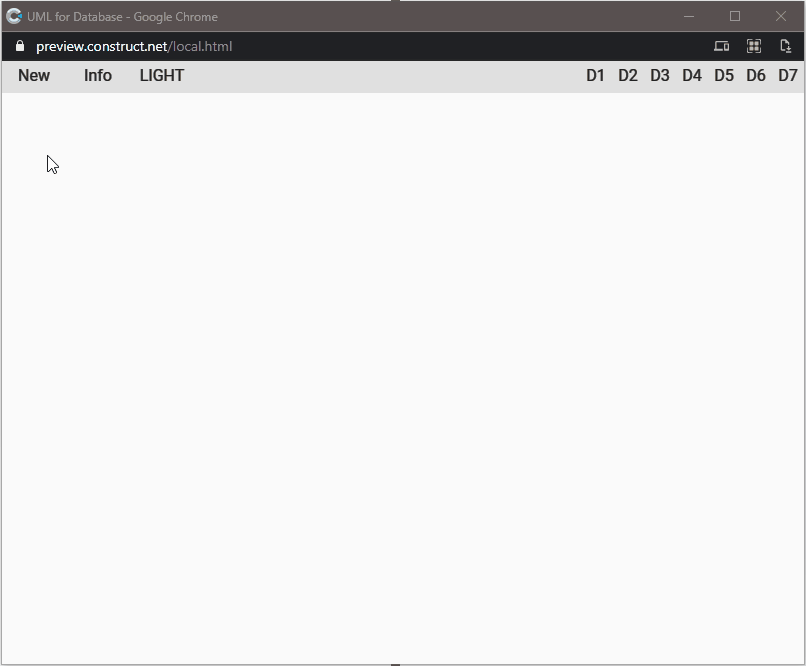The past two weeks have been pretty hard. A sudden death hit my family, annihilating us. Programming has generally always been a safe heaven to take refuge in, a chance to bring some order to my otherwise chaotic world. In part it was like that this time too, even if I didn’t want to publish, to share, to get in touch with the outside world. Anyway, this week’s project is an excerpt of an idea for a working project.

It is an experiment on how to graphically represent the relationships between tables in a database. This is not a complete thing, just the graphical interface, but there are 4 interesting aspects in my opinion:
- the ability to choose between a light theme and a dark theme
- creating a modal window above the application (in this case to show information about the app)
- the management of separate windows with the possibility of minimizing, maximizing and closing them
- the graphic representation of diagrams written in a textual language

The management of the themes is done through a global variable:
const Globals = {
theme: {
light: {
statusBar: "#E0E0E0",
appBar: "#F5F5F5",
background: "#FAFAFA",
card: "#FFFFFF",
textPrimary: "#222222",
secondaryText: "#455A64",
textDisabled: "#CFD8DC",
textInteractive: "#0071BC",
textError: "#BF0000"
},
dark: {
statusBar: "#000000",
appBar: "#212121",
background: "#303030",
card: "#424242",
textPrimary: "#FFFFFF",
secondaryText: "#B0BEC5",
textDisabled: "#B0BEC5",
textInteractive: "#FFFFFF",
textError: "#FFFFFF"
}
}
};
export default Globals;
To change the color of the different elements I use a function similar to this:
function themeColorize(name) {
const theme = Globals.theme.selected;
const instances = runtime.objects[name].getAllInstances();
for (const inst of instances){
const color = inst.instVars.Color;
const colorHEX = Globals.theme[theme][color];
inst.colorRgb = hexToRGBA(colorHEX);
}
}
For the management of the windows (including the modal one) I used WinBox.js, a library particularly suitable for this purpose. For example, a function similar to this is enough to open the window with the information about the application
function toggleWinInfo() {
const info = document.getElementById("winbox-info");
if (!info) {
const theme = Globals.theme.selected;
const projectName = runtime.projectName;
const projectVersion = runtime.projectVersion;
const html = `
<div style="text-align:center;" id="winbox-info">
<h3 style="color=${Globals.theme[theme].textPrimary}">${projectName}</h3>
<p style="color=${Globals.theme[theme].secondaryText}">v: ${projectVersion}</p>
</div>
`;
new WinBox({
title: "Info",
class: theme,
modal: true,
background: Globals.theme[theme].statusBar,
top: 32,
x: "center",
y: "center",
width: 200,
height: 150,
html
});
}
}

Finally the graphs. I chose to use Mermaid , a library that allows you to represent graphics and diagrams starting from a textual representation. Like Markdown, but for diagrams.
This part took a little more work because it requires integrating the creation of two new windows and their mutual linking. First I create the window to use as input:
const theme = Globals.theme.selected;
const htmlInput = `
<div class="editor" id="input-1" contenteditable="true"></div>
`;
new WinBox({
title: "INPUT",
class: theme,
background: Globals.theme[theme].statusBar,
top: 32,
html: htmlInput
});
Then I created the window to show the graph:
const theme = Globals.theme.selected;
const htmlOutput = `
<div id="output-1"></div>
`;
new WinBox({
title: "PREVIEW",
class: theme,
background: Globals.theme[theme].statusBar,
top: 32,
x: 32,
y: 32,
html: htmlOutput
});
Finally I connected the two windows in order to automatically update the drawing of the graph with each modification of the text contained in the first window.
document.getElementById("input-1").addEventListener("input", (e) => {
const output = document.getElementById("output-1");
if (output.firstChild !== null) {
output.innerHTML = "";
};
const code = e.target.innerText;
const insert = function (code) {
output.innerHTML = code;
};
mermaid.render("preparedScheme", code, insert);
});
As a final touch I added the ability to show some example code by importing it directly into the input window and updating the output window
function showDemo(code) {
const input = document.getElementById("input-1");
if (input) {
const number = localVars.number;
input.innerHTML = code
const output = document.getElementById("output-1");
if (output) {
if (output.firstChild !== null) {
output.innerHTML = "";
};
const insert = function (code) {
output.innerHTML = code.trim();
};
mermaid.render("preparedScheme", code, insert);
}
}
}
This project is currently a prototype but can already be used to test the potential of an application of this kind.
As usual I have shared the complete code on Github.



